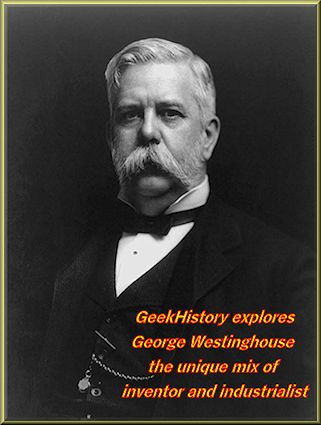 George Westinghouse is often listed as an industrialist or entrepreneur. Many times when people call someone an industrialist, rather than an inventor, they are implying the person was not an inventor themselves, but bought and sold other people's ideas. But George Westinghouse was very much an inventor, and a life long geek who loved to tinker with machinery.
George Westinghouse is often listed as an industrialist or entrepreneur. Many times when people call someone an industrialist, rather than an inventor, they are implying the person was not an inventor themselves, but bought and sold other people's ideas. But George Westinghouse was very much an inventor, and a life long geek who loved to tinker with machinery.
George Westinghouse was the son of a New York agricultural machinery maker, the owner of the G. Westinghouse and Company Schenectady Agricultural Works. As a boy George was not a good student, it is said he was bored in the classroom. He loved mechanics and working in the machine shops of his father's factory. A foreman in his father's shop took an interest in George junior and gave him the tools and encouragement to build water wheels and steam engines in his fathers shop. Later in life Westinghouse said the best education he had was the ability to work in his father's shops.
At an early age Westinghouse worked on various inventions involving rotary steam engines and improving the railway system, at age of 19 Westinghouse was awarded his first patent for a rotary steam engine. Westinghouse moved to Pittsburgh at the age of 21 in search of the steel he needed for his inventions in rail transportation. At age 22 he was awarded a patent for one of his most important inventions, the railroad air brake. This device enabled trains to be stopped with fail-safe accuracy by the locomotive engineer for the first time and was eventually adopted on the majority of the world's railroads. The Westinghouse Air Brake Company was founded on September 28, 1869 by George Westinghouse in Pittsburgh, Pennsylvania.
The War of Currents
Many articles are written about the great fight between Thomas Edison and Nikola Tesla over the distribution of electricity in America known as the War of Currents . What is really sad is all the internet hype on Nikola Tesla and the cries of how Tesla is forgotten. The often forgotten man who won the War of Currents against Thomas Edison was George Westinghouse.
Part of the Tesla mythology tells of how Tesla pitched the idea of AC power generation to Westinghouse. The concept of AC power distribution was not a new concept for Westinghouse, he was also an inventor in the gas industry. Working on the distribution of natural gas Westinghouse was awarded thirty-eight patents in that field. His knowledge of transferring gas over long distances had him thinking about ways to distribute electricity.
Westinghouse had a knack for spotting good ideas and people and bringing them into his fold, and he knew AC power distribution was a good idea. In 1885 Westinghouse became interested in the inventions of European Inventors Gaulard and Gibbs and purchased the American rights to their patents for AC current transformers. Westinghouse and his staff worked on improving and redesigning the transformers, and the Westinghouse Electric Company was started in 1886.
We will go into more detail on how George Westinghouse worked with Nikola Tesla to defeat Thomas Edison in the War of Currents in the article that follows this one.
The legacy of George Westinghouse
George Westinghouse, the son of a New York agricultural machinery maker, came to Pittsburgh in 1868 in search of steel for a new tool he designed to guide derailed train cars back onto the track. Before he left Pittsburgh to retire back to New York, Westinghouse gave the world safer rail transportation, steam turbines, gas lighting and heating, and brought electricity to the average American's home.
As you learn about George Westinghouse, and read the comments of his contemporaries, you get the sense that Westinghouse was a unique mix of inventor and industrialist. Without the quirks and craziness of his contemporaries, like Edison and Tesla, Westinghouse was well liked and respected by other business leaders as well as his employees and associates. Unlike Thomas Edison, who worked the media, and enjoyed the attention, Westinghouse did not seek the attention of the media.
A monument in Pittsburgh honoring Westinghouse was paid for by employees of Westinghouse companies. The Dedication Plaque located on the back side of the Westinghouse Memorial starts with the following sentence, "This memorial unveiled October 6, 1930, in honor of George Westinghouse is an enduring testimonial to the esteem, affection and loyalty of 60,000 employees of the great industrial organizations of which he was the founder."
During his career in Pittsburgh, George Westinghouse was involved in the founding of many companies using the Westinghouse name. The legacy of George Westinghouse lives on in many companies. There are numerous companies that have merged with other companies over the years that have roots dating back to the time of George Westinghouse.
The first major inventions of George Westinghouse were in the areas of railroad safety, specifically railroad air brakes. The Westinghouse Air Brake Company (WABCO) was founded on September 28, 1869 by George Westinghouse. WABCO's direct successor companies include WABCO Vehicle Control Systems, a commercial vehicle air brake manufacturer; and Wabtec, a railway equipment manufacturer, which have been owned and operated independently of each other since the mid-twentieth century.
WABCO Vehicle Control Systems is an American provider of electronic braking, stability, suspension and transmission automation systems for heavy duty commercial vehicles. WABCO employs more than 11000 people in 34 countries worldwide.
Wabtec Corporation (derived from Westinghouse Air Brake Technologies Corporation) is an American company formed by the merger of the Westinghouse Air Brake Company (WABCO) and MotivePower Industries Corporation in 1999.
The company that started out as the Westinghouse Electric Corporation founded in 1886 has evolved into two large global companies,CBS, an American broadcast network, and Westinghouse Electric Company LLC, a nuclear power business.
The Westinghouse Electric Corporation founded in 1886 entered the broadcasting business in 1920 with KDKA radio in Pittsburgh. The oldest surviving licensed commercial radio station in the United States, KDKA was an outgrowth of experimental station by Westinghouse assistant chief engineer Frank Conrad. Westinghouse purchased CBS in 1995. In 2000 CBS Corporation was merged into Viacom. In 2005 the CBS Corporation split off from Viacom. Thanks to the mechanics of mergers and acquisitions, technically the Westinghouse Electric Corporation founded in 1886 no longer exists, but the current CBS Corporation was the offspring that it produced
The modern company known as Westinghouse Electric Company LLC, a US based nuclear power company, is also technically not the same company as the original Westinghouse Electric founded in 1886. It is a spinoff company created in 1999, when CBS Corporation sold its nuclear business (Westinghouse Electric Company) to British Nuclear Fuels Limited (BNFL). Then British Nuclear Fuels Limited purchased ASEA Brown Boveri (ABB) Group's nuclear power business and merged the businesses together to form Westinghouse Electric Company LLC.
The legacy of Westinghouse patents
The rivalry between Edison and Westinghouse really hit home for me when I was visiting the Westinghouse exhibit at the Western Pennsylvania Museum in Pittsburgh. There is a hologram of George Westinghouse that answers commonly asked questions. One of the questions is who hold more patients, George Westinghouse or Thomas Edison. Westinghouse points out that in his company employees are allowed to register patients in their own name, but employees of Edison do not have that privilege. Patients filed for inventions while working for Edison are done in the name of Thomas Edison.
The question of how many patients George Westinghouse has is also raised in the video biographies of Westinghouse. One of the points often mentioned in Edison boasts is that Edison personally holds over 1000 patents. George Westinghouse personally held over 300 patients. According to a 2009 Westinghouse corporate profile, during the 20th century, Westinghouse engineers and scientists were granted more than 28,000 patents.
The famous line of comedian Rodney Dangerfield was "I get no respect." As so much written on the Internet about the infamous "War of Currents" being between Edison and Tesla, I think that same "I get no respect" tag line could be used to describe George Westinghouse.
If someday they say of me that in my work I have contributed something to the welfare and happiness of my fellow man, I shall be satisfied. -- George Westinghouse
